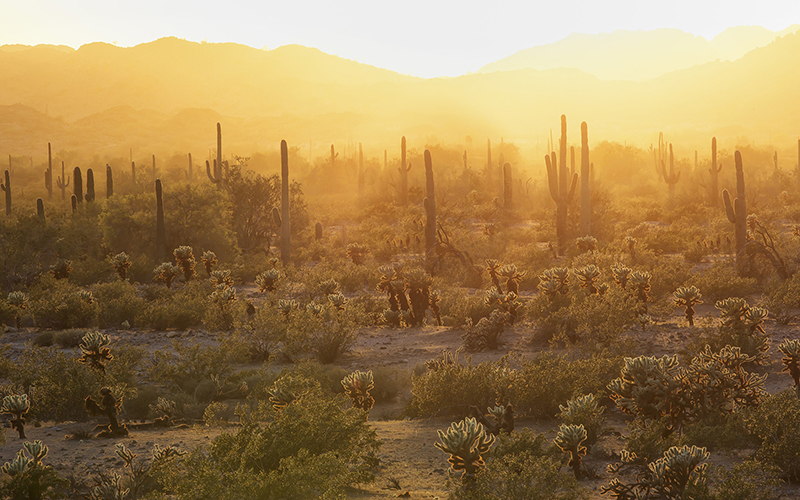
Environmentalists worry that target shooting could trash sensitive areas of the desert, but gun enthusiasts say there’s a place for responsible shooters. (Photo by Mitch Barrie/flickr via Creative Commons)

When it was designated by President Bill Clinton in 2001, the Sonoran Desert National Monument was called the most biologically diverse of the North American deserts. (Photo by Bob Wick/Bureau of Land Management)
WASHINGTON – Federal officials are moving forward with a proposal to allow target shooting on more than 470,000 acres of the Sonoran Desert National Monument – a stark change from a 2012 plan that would have limited shooting to just 84 acres.
The Bureau of Land Management proposal, which started a 60-day comment period last week, was seen as a “frustrating” reversal, according to the environmental groups that had sued to stop what they see as threats to natural and cultural assets in the park.
“The original draft of the resource management plan limited target shooting for well-documented reasons,” said Sandy Bahr, director of the Sierra Club’s Grand Canyon chapter, of the 2012 plan. “It then came back with an about-face because of what seemed like political reasons.”
But gun enthusiasts pointed to about 10,000 acres in the monument that are already closed to shooting, and welcomed the fact that the BLM plan might allow shooting in other areas.
“Arizona is no longer the open state it used to be, more and more places are closing to shooters,” said Arizona Outdoor Sports President Tom Slaughter.
“We want to work to keep public lands in the state open to responsible shooters like ours,” Slaughter said.
President Bill Clinton created the Sonoran Desert monument in 2001, noting that the lands already under federal management were the “most biologically diverse of the North American deserts.”
Work began a year later on environmental impact studies of potential uses for the land, which is home to numerous protected species and plants – like the Sonoran desert tortoise and the Saguaro Cactus – as well as cultural sites, like the Juan Bautista de Anza National Historic Trail.
Almost a decade and thousands of public comments later, the BLM issued a plan that called for a ban on sport shooting in all but 84 acres of the monument. Licensed hunting is still allowed. But after pushback from gun-rights groups, the Department of the Interior quickly ordered a rewrite of the plan to open more areas to recreational shooting.
The rewritten plan sparked a September 2013 lawsuit by Archaeology Southwest, the Wilderness Society and the National Trust for Historic Preservation, which claimed the proposal violated numerous environmental legislative acts.
In March 2015, a district court ordered BLM to close 2 percent of the monument to target shooting – or 10,599 of the monument’s most “heavily used acres” – until the government can develop an amendment that addresses the sport.
The court-ordered plan that put 2 percent of the monument off limits was posted to the Federal Register last week, starting a 60-day comment period during which BLM will seek to refine the monument’s resource management plan.
“We manage public land, and our whole goal is to encourage and show people how to enjoy public land,” BLM spokesman Adam Eggers said. “So we want it to be accessible to people for all kinds of activities, which could include target shooting, camping or bird watching.”
Ian Dowdy of the Sonoran Institute said he is dismayed by the amount of shooting currently being considered for the monument, but welcomed the opportunity for public input on the plan.
“It’s not about target shooting,” Dowdy said. “It’s about due process. It’s a good example of why we need to have an open discussion about what happens in public lands.”
Dowdy questioned whether BLM “acted appropriately, and if they listen to the people when constructing their plan.”
“It’s long past time we give everyone the right to use public lands within the confines of their passions and the current culture,” he said.
Dianne Olson said that does not have to be an either/or choice.
Olson is assistant director of Tread Lightly, a nonprofit that advocates for responsible outdoor recreation. She said her group is working with BLM to encourage “active stewardship,” in which visitors – including shooters – clean up after themselves and work to reduce environmental impact on public lands.
“In this area, we are particularly focused on recreational shooting,” Olson said. “Any activity can be done in a respectful manner, and we know there’s room for different activities on public lands.”
Eggers said BLM will accept comments by mail, email or at any of three public meetings tentatively scheduled for late February. The agency has until Sept. 30, 2017, to respond.
“We have to balance people who want to enjoy the monument now with those who want to enjoy it 60 years from now,” Eggers said. “Combining the public opinion with science will help us do that.”